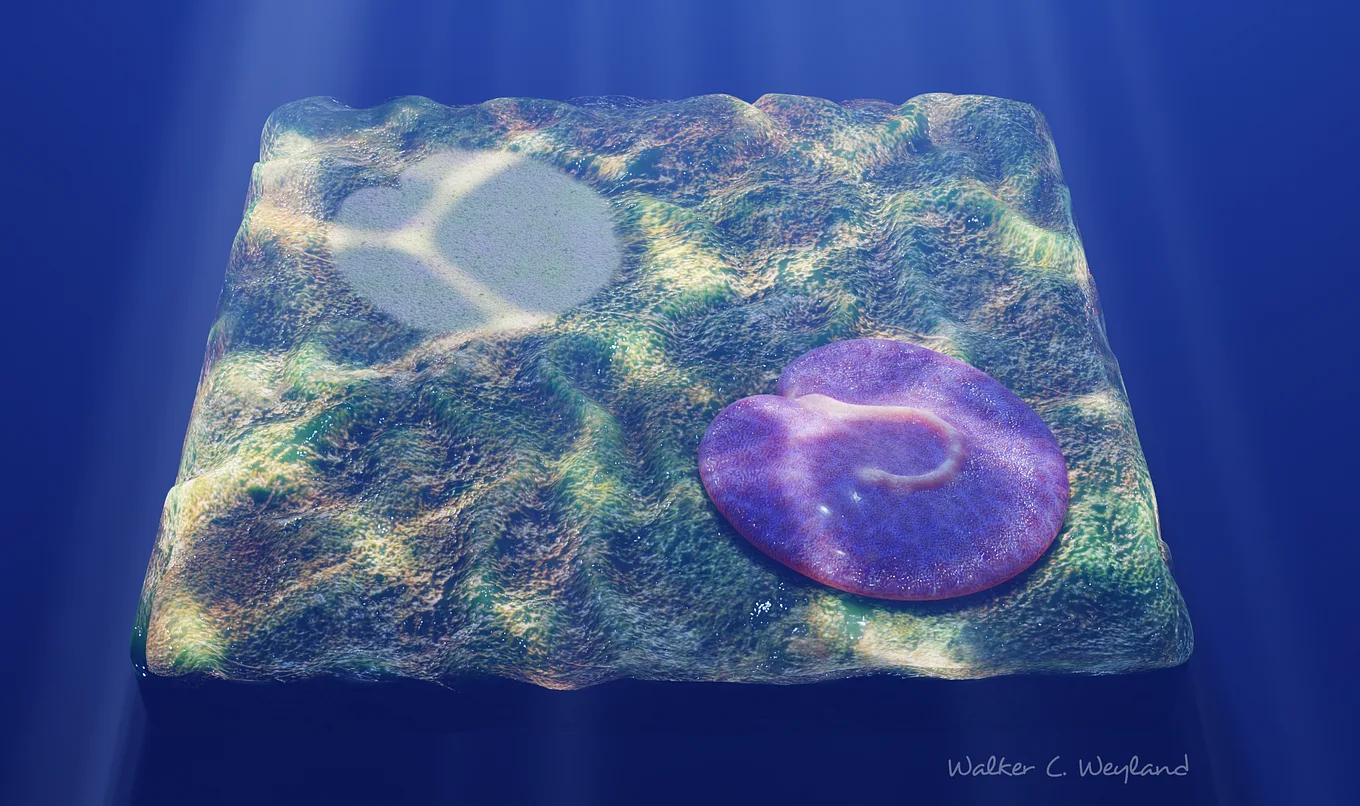Update from Mary Lou Simpson OAM
The Nilpena Ediacara National Park has now been open and attracting visitors for 18 months. The excellent work of research teams clearly on display has influenced many visitors to give their generous support to Foundation projects. All of these are intended to improve Park access and amplify awareness of Nilpena Ediacara values through interpretation and education.
Mary Lou Simpson, Foundation Chair
South Australian Tourism Awards
We’re extremely pleased to announce that Nilpena Ediacara National Park has recently taken out the 2024 Silver Award for Ecotourism.
Congratulations to Ranger in Charge Kim Geue and all responsible members of the National Parks and Wildlife Service team.
Ediacaran fossil named in honour of Mary Lou and Antony Simpson

Quaestio simpsonorum is revealing fascinating information about the first animal life on our planet. Researchers from US universities and the South Australian Museum have unearthed more than a dozen specimens of this important fossil find at Nilpena Ediacara National Park.
Its discovery is attracting international attention from specialist palaeontologists and evolutionary and developmental biologists. The peer-reviewed UK journal Evolution & Development, features Quaestio simpsonorum on the cover of its November 2024 edition and notes that the fossil carries the genus name Quaestio for the ridge in its centre that is shaped like a question mark.
Entirely new to science, simpsonorum joins more than a hundred multicellular organisms so far identified here from the Ediacaran period – an era some 635 to 538 million years ago – when the first complex, macroscopic animals emerged on Earth.
“Given our long association with the wonderful South Australian Museum,” said Mary Lou, “we feel privileged indeed to have our supportive role in this endeavour acknowledged in such a way.”
Measuring up to 8cm wide, these fossils are the preserved imprints of organisms that likely moved along what was once the seafloor but is now part of the majestic Flinders Ranges landscape.
Because no animals had yet evolved to burrow through the sediment, this seafloor accommodated a layer of microorganisms that moved around and fed on what can be described as a slimy organic mat.
Lead author of the study, Professor Scott Evans from Florida State University, said unique trace evidence uncovered by the research team suggests that Quaestio fed on this mat as it moved along.
“It really speaks to the unprecedented nature of the fossil record at Nilpena to have fossils preserved directly alongside evidence of their behaviour – in this case showing us how an animal that went extinct half a billion years ago got its food,” Professor Evans said.
Mary Lou and Antony Simpson have been involved with efforts to research and conserve the fossils at Nilpena for more than 20 years. Support from the Flinders Ranges Ediacara Foundation established by Mary Lou has been integral to the development of the Nilpena Ediacara National Park.
University of California Professor and palaeontologist Mary Droser, who along with staff from Harvard University was part of the team that made the discovery, said the fossil had some interesting features that made it stand out from other Ediacaran species.
“What is really exciting about this fossil is that it’s largely bilaterally symmetrical, which means its right side mirrors its left side, but then it has an asymmetrical element that forms the shape of a backwards question mark,” Professor Droser said.
“This sort of symmetry indicates a certain level of genetic complexity. Humans are bilaterally symmetrical but have a number of asymmetries, for example the location of the heart and appendix. A number of other such asymmetries are found throughout the animal kingdom – this appears to be one of the first organisms to organise itself in that way.”
“It’s fitting that our new fossil is named after Mary Lou and Antony Simpson, who have worked so tirelessly and enthusiastically to help preserve these fossils through the development of the Park,” she said.
National Parks and Wildlife Service (NPWS) Director of Regional Operations Stuart Paul, the Department for Environment and Water (DEW) Observer on the Foundation Board, said visitors were now enjoying guided tours of Nilpena Ediacara National Park, including its world-famous fossil beds.
“Nilpena is a site of huge international significance and there really is nowhere else like it in the world.”
ACTIVITIES AT THE PARK
Ranger’s report
The 2024 year at NENP has been very successful, with Ranger Kym Geue and his small team delivering NPWS-led tours to more than 1,500 guests. The feedback has been excellent, with the Blacksmith’s Shop AV presentation definitely a highlight.
A number of Certified Tour Operators are currently undergoing accreditation training with a view to entering the market in 2025.
Much of the restoration work on the beautiful historic woolshed has been completed. A new toilet block has been erected near the Blacksmith’s Shop and another three fossil beds were stabilised in June/July.

Digitising fossil beds
Thanks to a generous Sydney visitor who was inspired to support a research project, this gift has been directed to fund further digitising of the fossil beds by four of Professor Mary Droser’s students.
The aim is to have all the fossils and their co-ordinates on each bed – along with photos of each – logged digitally so that these data are freely available to international researchers and the public in general. The project will mark the establishment of a world-first “outdoor museum”.
This outstanding gift signifies an encouraging start to a process that will impact world heritage and research for years to come.

Visitor reactions
With a strong focus on conserving wildlife and connecting people with nature, Professor Chris Daniels is a prominent biologist and zoologist with high-level academic connections. He is a Governor of the World Wildlife Fund and sits on the boards of several institutions, including the RSPCA and SA Museum.
His informed impressions following a tour of the Park were positive indeed.
“The fossil site and interpretation centre are excellent educational and informative exhibition models. They’re underpinned and supported by collections and form an exemplary focus of local and international research.”
Adelaide GP Andrew Kilcross, an early visitor to the Park, was inspired to write a piece of music for full orchestra entitled ‘Ediacara’. It chronicles the evolution of the Ediacaran microorganisms, beginning in the ice age and moving through eight eras to the eventual rising of the Flinders Ranges and with them the seafloor Ediacaran fossil beds.
Click here to listen to a short demonstration
The Fossil Rock video for 5 -7 year olds
A huge thank you to all of our donors who supported the production of “Fossil Rock.”
The Foundation is proud to provide backing for this fun and educational endeavour which aims to highlight the Flinders Ranges’ rich Ediacaran heritage in a way that will spark curiosity in young minds.
Fastbreak Films and Sea Star Rock have completed shooting of this innovative kids’ video at the Park. The team is now diving into post production, where animation and music will bring the ancient story of Ediacara fossils to life for early learners.

The crew, led by Fastbreak Films’ Kylie Claude and Sea Star Rock’s Lucy Rasheed, enjoyed an extraordinary location shoot. The production was a true adventure as the team experienced sun-drenched days, unexpected rain and even a desert sandstorm.
“Mother Nature threw everything at us, but it only added to the magic of filming in such a unique, natural setting. Lucy has this natural connection with the landscape, which is so infectious. She made every scene feel like a fun discovery—her joy really shines through,” Kylie said.
Lucy Rasheed grew up in the Flinders Ranges and brings a joyful energy to the show as its host. Hers is a familiar face to young audiences and her playful approach helps distil complex scientific information into something accessible and entertaining. She leads a sing-and-dance-along journey, where kids can engage with the wonders of ancient fossils while having fun.
Joining the adventure was farmer Ross Fargher, whose local knowledge was invaluable. The production also benefited from the expertise of renowned palaeontologist Professor Mary Droser, who led a team of experts to ensure scientific accuracy.
Mary and her cohort have been collaborating with the research scientists at the South Australian Museum for more than 20 years.
“Their input helped us ensure the fossils we feature are not just fun but factually correct,” Kylie said. “It’s been a great collaboration.”
Support from DEW Ranger Kym Geue allowed ensured access to key fossil sites and a smooth experience on location. In a special local touch, school children from Hawker participated in the filming, bringing extra energy and excitement to the scenes. Their involvement helped build the show’s community spirit and connection to the Flinders Ranges region.
Fossil Rock will feature sing-and-dance-along soundtracks which blend science with music to keep the kids engaged and learning. The show is set to be released later this year and promises to be a must-watch for families interested in fun and educational content.
WHAT ARE OUR PRIORITIES FOR THE NEXT TWO TO THREE YEARS?
To improve access to and awareness of Nilpena Ediacara heritage values through interpretation and education, the Foundation is partnering with the Department for Environment and Water to seek a Commonwealth National Heritage Grant for $200,000.
Our chances of a successful application could well be boosted by recent news that several of the Park’s supporters have already contributed the remarkable amount of $104,000 in supplementary funding.
What projects would benefit from this National Heritage Grant?
There are several interpretive, educational and visitor experience proposals planned for implementation at Nilpena Ediacara National Park over the next one to three years. Currently taking shape, they include:
- The installation of a second bench seat embedded with fossils at the front of the Blacksmith’s Shop. This will provide extra seating for tour guests and the opportunity to identify and touch the real fossils implanted. The total budget, including design, materials and building will be around $10,000. In July 2024, a visiting group of 22 from Adelaide were so impressed with their experience that they made a significant donation to assist this proposal.
- Creating an interpretive walk for visitors between the Blacksmith’s Shop and the Woolshed. This will feature information posts along the way representing the geological time line from present pastoral days dating way back to the Ediacaran period, 550 million years ago. The budget for this project is being costed based on current design work and is expected to be in the order of $30,000. We are partly there as some from the same group above have open-handedly donated and pledged assistance.
- Developing tour narration products. Because the fossil fields at Nilpena are central to the current World Heritage Listing nomination for sites in the northern Flinders Ranges, we are expecting an increase in international visitors. The development of translated narration aids that ensure visitors with little or no English can access tour interpretation in a variety of languages is a priority. Initial project estimates for this package of work are $50,000.
- Offering educational opportunities for students and others who are not able to travel to the park. We plan to develop an app-based game that will focus on exploring and identifying Ediacaran fauna in an engaging manner. The app is directed at students but will be accessible to all. The project cost estimate (provided by the expert digital development team behind the Blacksmith’s Shop AV experience) is $75,000.
We’re delighted to say that a philanthropic friend of the Park has covered this amount in full. Grateful thanks are very much in order.
- Providing special transport. With tourism developing and visitor numbers to the park increasing, the National Parks and Wildlife Service plans to purchase a 22-seat 4WD bus, with disabled access, to be available in 2025. There is a strong business case for such a critical asset and quotes obtained are in the order of $250,000. The Foundation plans to raise $10,000 to support this purchase, given the opportunity that exists to increase visitor numbers and raise its public profile.
Another project worthy of your support:
Ediacara Teacher Scholarships
This worthwhile $15,000 project aims to increase student engagement and learning about Ediacara via their teachers’ first-hand experiences.
Earlier this year, the Foundation offered ten scholarships to teachers at primary and secondary level, government and non-government schools. These were briskly taken up and successful applicants took part in a four-day Flinders Ranges immersive learning experience.
At the Park, they explored the fossil beds and engaged in a hands-on research activities during a palaeontology workshop with Professor Mary Droser which included fossil moulding in silicone and plaster – techniques to take back to the classroom.
The immediate effect was so positive that we plan to continue this project next year by setting up future scholarships in collaboration with the South Australian Science Teachers Association (SASTA). To demonstrate their impact, we’ve excerpted comments from articles in the latest edition of the SASTA Journal:
One teacher reported, “The chance to learn from someone like Mary, who is literally pushing the boundaries of our understanding of life on Earth, was something I’ll never forget. It made me excited not just for what I learned, but for what I’ll be able to share with my students.”
Another said “This trip has completely transformed how I think about teaching geology and palaeontology. I want my students to feel the same sense of excitement that I felt holding those fossils and walking through Brachina Gorge.”
From another: “Standing in the presence of these ancient fossils was incredible. It’s one thing to talk about the Ediacaran period in the classroom, but it’s something entirely different to see the evidence of it right in front of you.”
We invite you to make a tax-deductible gift of any amount via our website
Please let us know if you would like your donation to be directed toward a specific project.
You can take pride in being part of Nilpena Ediacara National Park projects that form a keystone of the government’s bid for parts of the Flinders Ranges to receive World Heritage Listing.
For more information contact Mary Lou Simpson on 0419 812 160 or marylou.simpson@ediacarafoundation.org




